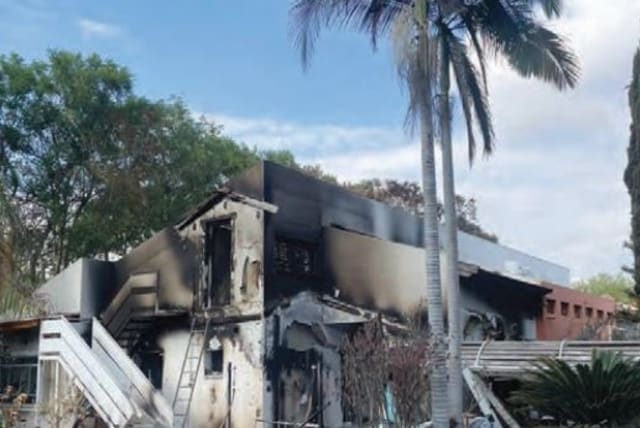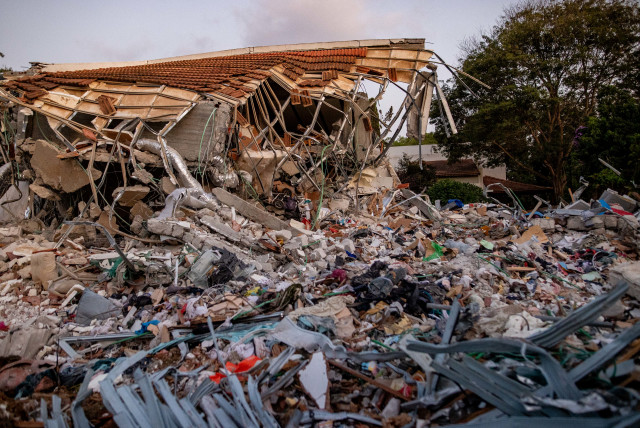Editor's Notes: Now I know what death smells like

I had heard about the smell of death before, but I never quite knew what it was. Now I do. It hung over the entire kibbutz, thick and nauseating.
Kibbutz Be’eri is remarkably peaceful.
Established in 1946, the community had a population of 1,047 in 2021. Verdant lawns stretch between small public buildings and houses shielded by leafy trees. The kibbutz is home to a printing press that serves as the community’s main source of income, as well as a veterinary clinic and a cycling center, and it is surrounded by agricultural fields. In wintertime, families from across the country flock to the adjacent Be’eri Forest to see the bright red anemones that blanket the area. Some years ago, the community – a bastion of liberalism and home to several prominent peace activists – established a fund to help support Palestinian families just a couple of miles away in Gaza.
At 6:30 a.m. on Saturday, October 7, Hamas launched a heavy barrage of rockets from Gaza into southern Israel. Using the rocket fire as cover, an estimated 2,900 Hamas terrorists utilized bulldozers to tear through the border fence and then drove through on motorcycles and pickup trucks. They then fanned out, making their way directly to kibbutzim and towns throughout the border area.
When they got to Be’eri, they immediately killed the community’s emergency readiness squad and set up an ambush at the main gate to prevent Israeli forces from coming to the rescue. Then approximately 100 terrorists drove into the kibbutz, dismounted their vehicles, and started going house to house, killing everyone they saw. They wrenched open the trunks of parked cars, removed spare tires, set them on fire, and rolled them into houses in order to burn the families inside to death. Anyone who fled the flames was shot. They fired rocket-propelled grenades at fortified safe rooms in order to get to the families huddled inside.
Within hours, large numbers of soldiers arrived and, after sustaining significant losses, overpowered the terrorists at the kibbutz gate. A fierce gun battle erupted. The army sent several tanks into the community and started shelling some of the houses from which terrorists were firing. The firefight stretched into the middle of the next day, until all the terrorists were dead.
A friend of mine who scrambled to Be’eri with his reserve unit that day said it looked like something out of a horror movie. “Never in my life did I imagine that humans could be so cruel to each other, and that I would see it,” he told me. He described seeing bodies everywhere, smoke wafting through the kibbutz.
At least 104 members of the community – approximately 10% of its total population – were murdered that day, along with six police officers. Multiple residents were kidnapped by Hamas and are being held hostage in Gaza; we still don’t know exactly how many.
I visited Be’eri earlier this week with a colleague, part of a group of editors from Israeli media outlets invited to tour the site.
As we made our way from Jerusalem, we saw long lines of parked cars outside army bases, left there by reservists reporting for duty. Nearing the Gaza border area, we had to pass through several checkpoints, and the IDF’s presence became increasingly visible. As we approached Be’eri, we drove past neighboring Kibbutz Re’im, where the terrorists had targeted a music festival, killing at least 260 young people. Many of the victims’ cars remain on the side of the road.
Today, Be’eri is an armed camp; the surviving residents have been evacuated, replaced by military personnel. Several tanks are parked in a large dusty expanse next to the entrance. The yellow kibbutz gate is halfopen, blackened by fire. When we arrived, hundreds of soldiers were having lunch on the grass; some were lying on the ground napping. Military vehicles were all over the place. Military officials believe dozens of terrorists remain in hiding in Israel; they aren’t taking any chances.
Wearing flak jackets and helmets and accompanied by soldiers with rifles at the ready, we walked around what remains of the kibbutz, guided by several senior officers who had participated in the battles there. Many of the houses have been totally consumed by fires, while others were reduced to piles of rubble. Others still are almost completely intact, doors left open as though the residents had just stepped out to grab a cup of coffee with a neighbor.
I peered into one of the homes. Aside from a shattered window, shards of glass on the floor, and a few out-of-place rugs and cushions, it looked totally normal. The living room’s heavy maroon couches and framed still lifes suggested the aesthetic of an older couple. A custom calendar with family photos adorned one wall, alongside a colorful wall hanging with grandchildren’s birthdays marked ‘Grandpa Yitzhak’s exciting dates.’ An open bottle of Fanta Zero remained on the kitchen counter.
Across from that house was a landscape of devastation. Terrorists had barricaded themselves in a house, forcing the army to demolish it. Searching through the rubble, the soldiers found the bodies of eight small children who had been tied up and executed. They also uncovered the bodies of a couple who were embracing at the time of their death.
The signs of the carnage were everywhere. A blood-stained boulder here, a crumpled prayer rug there. Two white pickup trucks used by the terrorists stood idle in a sandy lot; one of them had had a heavy machine gun – since removed – mounted on the back. The ground was littered with thousands of bullet casings.
As we walked around, confronted with the scale of the massacre, it struck me that the only place in which I had a similar feeling was in Poland, visiting the sites of mass murder during the Holocaust.
The terrorists who carried out the October 7 massacre have been likened by the Israeli commanders who confronted them to the Einsatzgruppen, the SS death squads tasked with killing Jews and other undesirables, generally by mass shootings. Like the German killing units, the Hamas terrorists roamed through villages and towns with the express goal of finding and murdering innocent civilians. Security forces were mere obstacles to be removed as the terrorists made their way to their intended targets.
As we left Be’eri, we went past two concrete bomb shelters placed next to bus stops. These small structures offer protection during the rocket attacks that have battered the region for years. On October 7, people fleeing the music festival in Re’im sought shelter in these structures, thinking they would be safe. The terrorists went up to them, lobbed hand grenades inside, and shot anyone who survived. When we stopped to inspect the shelters, we found shoes and articles of clothing scattered on the ground, along with bullet casings. Inside, the walls were blackened and pocked with shrapnel; the concrete floors were covered in dried blood.
Two days after our visit, rescue workers found two more blackened bodies in Be’eri. The first was of a child of five or six who had apparently been hiding in an attic; the second was of a middle-aged woman, believed to have been the child’s mother. Both were burned to death when the house was set on fire.
Heroism and sacrifice
There are also incredible stories of heroism and sacrifice from that hellish day in Be’eri.
Two brothers, Elhanan and Menachem Kalmanson, and their nephew jumped in a car and drove to the kibbutz when they heard what was going on. Together, over the course of more than 14 hours and while under constant fire, they rescued dozens of residents, including pregnant women, elderly people, and a young girl who was found hiding in a closet after her parents were killed. As they approached the last house, a terrorist who had been hiding opened fire on the three. Elhanan was hit and fatally wounded.
Kibbutz paramedic Amit Mann, 22, was on call the morning of the massacre. She set about tending to the wounded for six hours until the terrorists reached the clinic. “I don’t think I’m going to make it out alive,” she texted her family as she hid in the kitchen. “I love you.” Her body was found two days later.
Soldiers and officers who were wounded insisted on continuing to fight; several returned to the battle freshly bandaged. The IDF’s canine unit, Oketz, played a central role in rescuing the residents of the kibbutz. Bedouin kitchen workers from the kibbutz dining hall were among the first to alert security forces and helped save several residents under fire.
I won’t soon forget what I saw and heard about in Be’eri, but what I will remember most of all is the smell. I had heard about the smell of death before, but I never quite knew what it was. Now I do. It hung over the entire kibbutz, thick and nauseating. In the airless bomb shelters, it was so overpowering that it caused me to gag. It is still lingering in my nostrils as I write this three days later.
Driving back to Jerusalem, we passed Be’eri’s green fields, which stretch as far as the eye can see. Much to our surprise, the sprinklers were on, irrigating the crops in wide arcs. Whether they were left on by the now-absent residents or activated in the interim, I don’t know, but they left me with a small measure of hope that perhaps, someday, this shattered community will rise again.
Jerusalem Post Store
`; document.getElementById("linkPremium").innerHTML = cont; var divWithLink = document.getElementById("premium-link"); if (divWithLink !== null && divWithLink !== 'undefined') { divWithLink.style.border = "solid 1px #cb0f3e"; divWithLink.style.textAlign = "center"; divWithLink.style.marginBottom = "15px"; divWithLink.style.marginTop = "15px"; divWithLink.style.width = "100%"; divWithLink.style.backgroundColor = "#122952"; divWithLink.style.color = "#ffffff"; divWithLink.style.lineHeight = "1.5"; } } (function (v, i) { });

